 advertisements advertisements
|

|
'Space cola wars' at 35: When Coca-Cola, Pepsi tested soda in space
August 11, 2020 — John-David Bartoe was having none of it.
A payload specialist aboard a 1985 flight of the space shuttle Challenger, Bartoe sequestered himself away from his six crewmates. He was glad to be on his first mission and even happier to have made it safely into space after what was the space shuttle program's first and only abort-to-orbit, but becoming one of the first astronauts to drink Coca-Cola or Pepsi off Earth was a sip too far.
"I thought it was frivolous and detracting from the science of the mission. I didn't like it all," said Bartoe, reflecting 35 years later on what the media dubbed then the "space cola wars." "I said, 'I'm not going to do it, I think it it's a terrible idea.'"
So while his STS-51F crewmates took turns testing out either Coke's or Pepsi's soda cans developed for use in space, Bartoe stayed apart.
"In retrospect," he told collectSPACE in a recent interview, "that was really a dumb thing for me to do."
Carbonated Beverage Container Evaluation
Coca-Cola was the first to approach NASA about testing a soda dispenser aboard the space shuttle.
Given the way that liquids can behave in the microgravity environment of Earth orbit, launching off-the-shelf soda cans or bottles would not work. A mechanism is needed to push or extract the liquid out of the container, but only when desired by the astronaut to avoid making a mess of the cabin.
Coca-Cola invested about a quarter of a million dollars to adapt what looked like one of its aluminum cans to hold a laminated plastic bag filled with soda and a carbon dioxide-pressurized bladder to propel the drink out. The can was topped with a metal valve and a drinking spout.
When Pepsi got word that Coca-Cola was going to space, it appealed to NASA to be included on the mission, as well. The agency agreed, but only if Pepsi could develop and deliver a dispenser in time.
For its can, Pepsi modified an existing design that it said originally cost $14 million to develop. Similar to the dispensers used to package spray cheese or whipped cream, Pepsi's space can also used a carbon dioxide-filled pouch to push the soda out, but instead of being pre-pressurized, it employed chemicals to produce the gas.
"This started out as a very serious research project for the Coca-Cola company. They wanted to see if they could develop a can that could dispense a carbonated beverage in space just as if you were drinking it here on the ground. So they put their engineers to work and came up with this high-tech can," Bartoe said. "The Pepsi can was made last minute in a big rush. It was not nearly as high tech and was more like a whipped cream can with a little white tab tipped sideways."
NASA, seeking to downplay the commercial nature of the payload, referred to the Coke and Pepsi cans as the "Carbonated Beverage Container Evaluation" (CBCE) and relegated the activity to whenever the crew had time between what was the primary focus of the STS-51F mission, advancing the study of solar, atmospheric and astro-physics.
Divide and dispense
"There was some reluctance on the part of the crew, because it seemed so commercial," said Tony England, who like Bartoe was on his first and only space mission as a member of the STS-51F crew. "It wasn't really until we recast it as 'Can we use carbonated beverages?' that it seemed like a reasonable request."
Prior to the launch, four of each company's cans were packed aboard the shuttle and NASA and the astronauts agreed to some rules. To begin, the crew would limit any critiques to how the cans functioned and avoid commenting on the beverages inside.
The astronauts — and more importantly, Coca-Cola and Pepsi — wanted to stay clear of any questions about which tasted better.
Gordon Fullerton, the mission's commander, decided that the easiest way to limit the crew's involvement would be to have only Bartoe and Loren Acton, the flight's other payload specialist, drink from the cans.
But Bartoe did not want to be any part of it.
"He could have put my alternate [crew member] on board right there at that moment, but he went off and thought about it," said Bartoe, recalling Fullerton's reaction. "He said, 'Okay, new plan: everybody is going to drink — except John. Three of us will drink Pepsi and three will drink the Coke.'"
So when it came time to drink, Bartoe was "banned to the flight deck," Fullerton, England and mission specialist Story Musgrave tried out the Coke and Acton, pilot Roy Bridges and mission specialist Karl Henize drank the Pepsi.
All gassed up and nowhere to go
The STS-51F crew held the results of the carbonated beverage container evaluation private until their first post-flight press conference on Aug. 14, 1985, a week after they had landed back on Earth.
The astronauts knew before they launched that the soda was going to be at room temperature. The eight cans were loaded onto Challenger chilled, but without a refrigerator on board, there was no way to keep them cold.
The temperature was not a problem.
"The taste was surprisingly, or perhaps not surprisingly, as you would expect. It was a fine taste. There was nothing wrong with that," England told collectSPACE.
The cans, themselves, also seemed to work as intended.
"Both cans seemed to work fine," said England. "When we opened them, they did not explode or anything of that sort. And the drink was immediately available upon attempting to drink."
The Pepsi can dispensed a more frothy liquid, though, which led to the astronauts playing with fizzy Pepsi balls.
The major issue was the beverage being evaluated, said England, and its ability to bring on "wet burps."
"The problem was with carbonated beverages. When you open a bottle on Earth, the bubbles come up and they leave. Well, as you can imagine, if there's no gravity, the bubbles don't come up," he said. "So here you are with his stomach full of carbonated beverage, with the gasses kind of comfortably staying there."
Can response
Coca-Cola declared first place in the initial "space cola war," based on the crew having tested its can before Pepsi's. "Coca-Cola, the first choice in refreshment around the world, is now the first soft drink tasted in space," the company stated in an advertisement at the time.
Both companies partnered with educational groups to celebrate their beverages' first launch. Pepsi produced replicas of its space can that promoted the Young Astronauts organization, while Coca-Cola licensed U.S. Space Camp to sell a plastic version of its dispenser. Coca-Cola also gifted its distributors and museums with duplicates of its can.
NASA presented the Smithsonian National Air and Space Museum with examples of both the Coca-Cola and Pepsi cans, which went on display in Washington, D.C.
Pepsi's space can did not fly again, though the company did launch an oversize inflatable can (of the style used on Earth) to film a commercial aboard the Russian space station Mir in 1996.
Coca-Cola continued trying to develop a drink for the astronauts. In 1991, it flew its STS-51F-style can to Mir to similar results. The company then changed its approach, launching two versions of a dispensing machine ("Fluids Generic Bioprocessing Apparatus"), which could be used to fill either a pressurized cup or bottle with a choice of different Coca-Cola carbonated beverages, on STS-63 in 1995 and STS-77 the following year.
Since then, Coca-Cola has remained on Earth.
"I wonder if they would be fine in the one-sixth G on the moon or one-third G on Mars," said Bartoe, who has embraced the value of the STS-51F experiment in the 35 years since. "You could do some experiments on the space station to try to figure that out — if you really cared that much about having a soda in space." |
|
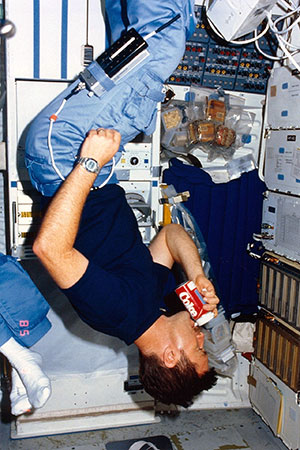
NASA astronaut Tony England, STS-51F mission specialist, drinks from a Coca-Cola space can as part of the Carbonated Beverage Dispenser Evaluation on space shuttle Challenger in 1985. (NASA)
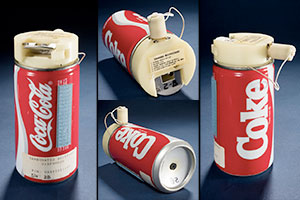
Coca-Cola's can for the STS-51F Carbonated Beverage Container Evaluation included an internal pressurized bladder and a teflon cap with a metal release valve and drinking spout. (Smithsonian)
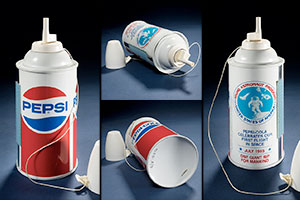
Pepsi's can for the Carbonated Beverage Container Evaluation on STS-51F included an inflatable internal pouch and design adapted from spray cheese and whipped cream dispensers. (Smithsonian)
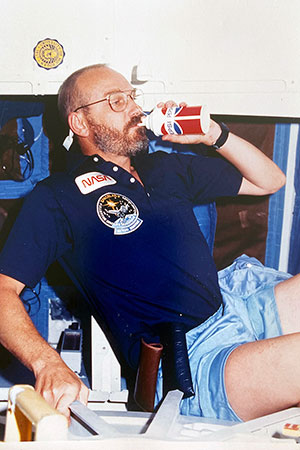
STS-51F payload specialist Loren Acton evaluates a Pepsi space soda can aboard space shuttle Challenger in 1985. (NASA)
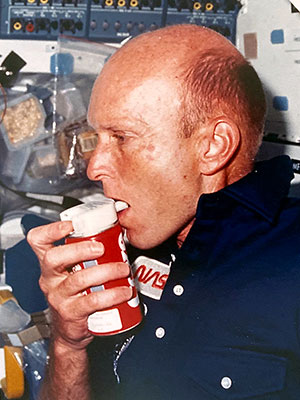
Gordon Fullerton, STS-51F mission commander, seen here with a Coca-Cola can, initially was only going to have the flight's payload specialists evaluate the soda dispensers. (NASA)
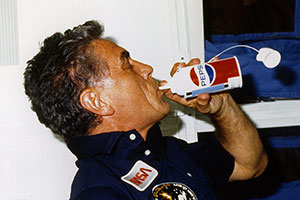
Karl Henize, STS-51F mission specialist, drinks from a Pepsi can on the mid-deck of space shuttle Challenger in 1985. (NASA) |
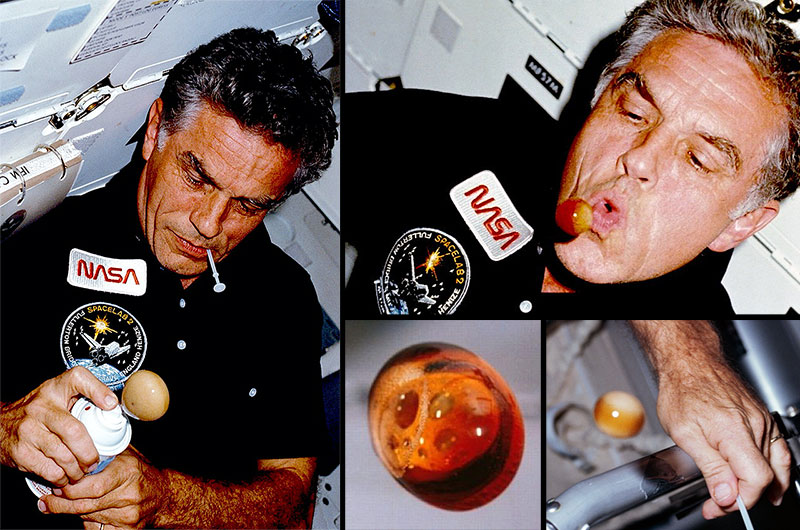
Karl Henize, STS-51F mission specialist, creates frothy, fizzing Pepsi soda balls during the Carbonated Beverage Dispenser Evaluation on board the space shuttle Challenger in 1985. (NASA) |
|

© collectSPACE. All rights reserved.
|
|

|

|
